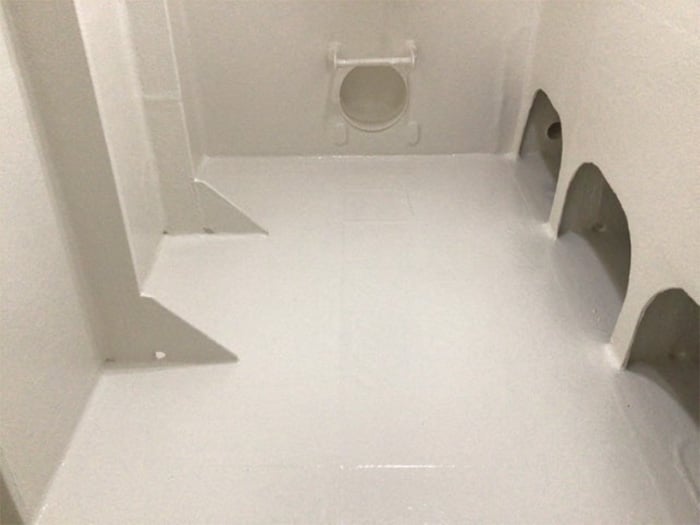
Tnemec solves scrubber system tank coating problem
Written by Nick Blenkey
Open-loop scrubber tank of Vulkan Materials’ self-discharging bulker after recoating with Tnemec system
Exhaust gas scrubber systems are not always problem-free and when America’s largest producer of construction aggregates, Vulcan Materials Company, encountered coatings issues with the scrubber system tanks in the 2018-built, 66,445 dwt self-discharging bulker Donald M. James it reached out to a specialist, Tnemec Company Inc., for a solution.
Vulcan uses the Bahamas-flagged Donald M. James to transport limestone aggregate between Mexico and the U.S. Gulf Coast and opted to comply with the IMO 2020 sulfur limits by fitting the ship with a scrubber. To protect the scrubber system’s tanks, a pin-hole-free, high-performance lining, was required.
When the original coatings systems on the scrubber tanks experienced early failures, Vulcan Materials knew another solution was needed. With the help of Wilhelmsen Ship Management (WSM), the team set out to find the right coatings system for the job and reached out to Tnemec and the local agency in Alabama, SteelCon Coatings Systems.
SteelCon was able to work with WSM to quickly provide a project specification for the vessel’s tanks in the short time frame the ship was docked. Understanding the urgency and knowing most vinyl ester coatings are “made to order,” Tnemec was able to speed up the manufacturing timeline to help the Donald M. James get off the dock and back to work.
The specification included a complete vinyl ester system using Tnemec Vinester 1407, 1436, and 1416. The team also added fiberglass chop strand mats to areas that typically see coating failures for added protection.
“We made sure to have a Tnemec NACE certified coatings inspector onsite throughout the duration of the application of the first tank to ensure the coatings were applied to specification,” said Andy Margarit, sales director, marine, at Tnemec. “The vessel captain, WSM, TAM Services, and Tnemec worked together to apply the extremely technical system, all while navigating the small confines inside the tanks. It was quite a feat.”
First, Tnemec VInester 1407 was applied on the tank welds and then a full coat of 1407 was applied to the entire tank. Next, a coat of Tnemec Vinester 1436, a premium grade novolac vinyl ester with glass flakes in the lining was applied at 25-30 mils and immediately embedded with a corrosion-resistant fiberglass chop strand mat. The reinforcing mat was wetted with Vinester 1416, a pure novolac vinyl ester, referred to in the business as a saturant coat. A coat of 1436 at 25-30 mils was then applied three feet up the bulkheads and the floor was completed with the coating/mat and saturant system. To finish the tanks, 1436, in a bright white finish, improving visibility in the enclosed space, was applied over the entire surface as the final protective layer.
The project took a total of two weeks to complete. Within that time, more than 400 gallons of made-to-order high-performance coatings were installed on the scrubber tanks. Despite the challenges many coatings companies were facing in supplying vinyl ester systems, Tnemec was able to deliver the coatings directly from the manufacturing plant in Kansas City to the ship docks in Mobile, Alabama, avoiding delays in freight transit time. This kept the project on track allowing the vessel to leave the port on time.




